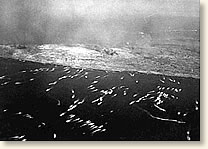|

The first wave hits the beach
|
Iwo Jima means "Sulfur Island", an apt description of eight square miles of volcanic, treeless scrub. Dominated by 546-foot Mount Suribachi, the island became the site of one of the bloodiest battles in World War II. Its strategic importance lay in its location halfway between Japan and the airfields of the B-29 Super Fortresses located on the Mariana Islands. Capture of Iwo Jima by the Americans would provide an emergency landing field for crippled bombers returning from their bombing raids on Japan and an advance base for the shorter-ranged escort fighters.
The American's strategic timetable demanded that the island be secured in the early months of 1945. Continuous air and naval bombardment began 74 days before the scheduled invasion to prepare the way. Previous Island assaults had taught the Americans the hard lesson that the Japanese would fight to the last man to defend their positions. The massive bombardment was meant to smash the Japanese defensive
As the invasion unfolded on the morning of February 15, the plan seemed a success. Huddled in their landing craft, the Marines encountered only scattered fire as they approached the beach. This situation didn't last long. Unbeknownst to the invaders, the Japanese had dug a labyrinth of tunnels and caves throughout the island that had protected them from the aerial bombardment. As the assault troops scrambled up the volcanic beach, the Japanese opened up with everything they had. It was a blood bath with the Marines pinned down by withering fire.
The invasion plan called for the quick capture of the heights of Mt. Surabachi. Two days after the invasion, however, the Marines had advanced only 200 yards towards their goal. It was not until the 23rd that they were able to wrest the mountain's summit from the enemy and another three weeks before they secured the entire island. Nearly all the island's 21,000 defenders died in the battle while the Americans lost 6,821.
References: Ross, Bill., Iwo Jima: Legacy of Valor (1985); Wheeler, Richard, Iwo (1980).
Read an EyeWitness account of the flag-raising at Iwo Jima 
|






